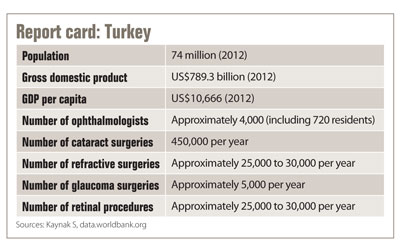Active aging population increases demand for ocular surgery in Turkey
The national ophthalmic industry has grown in parallel, covering approximately half of the internal IOL market.
Ocular surgery in Turkey has advanced significantly in recent times. The number of cataract surgeries has gone up to 450,000 per year, 70% are performed in the private sector, premium IOLs are used in 10% of the cases, and 10 femtosecond laser stations for cataract surgery are operating in the country.
“This fast increase is not only due to the growth of the elderly population, but also to the enhanced quality of life and early requests for surgery by privileged sections in society. The group in the population that drives cars and uses computers and mobile phones has reached the third age and wants to retain the best visual performance,” Süleyman Kaynak, MD, past president of the Turkish Ophthalmology Society, said.
Refractive surgery has advanced, too, and LASIK is quite popular and performed for reasonable prices. There are about 150 excimer laser stations, some of which are also used for the high volume of international health tourism patients.
The local ophthalmic industry has grown rapidly in parallel to this development, Kaynak said. Several companies produce standard and premium IOLs, as well as viscoelastics and other surgical materials. They appeal to approximately half of the IOL market and export to the whole world.
Turkey can rely on its own national donor cornea supply through the 33 eye banks established by the Ministry of Health. Nearly 2,850 keratoplasty procedures are carried out per year, and only from time to time a very limited cornea importation takes place.

Glaucoma, diabetic retinopathy and age-related macular degeneration are important issues in the older population. The diabetes rate in people older than 20 years is 13.7%, which corresponds to 7.5 million diabetic patients. Clinically significant macula edema occurs in about 12% of these patients, according to national statistics.
AMD affects 300,000 new patients annually; 30,000 of these are wet types with emerging treatment indications.
“Intravitreal injections due to various causes are estimated to be around 14,000 monthly,” Kaynak said.
Funding, education and delivery of care
Turkey is an important geographical and political bridge between the Middle East and Europe. Accession to the EU, for which Turkey was recognized as an official candidate in 1999, has sparked controversy on both sides. However, while negotiations are ongoing, Turkey is consolidating its economic partnership with Europe.
The country’s population is approximately 74 million, 25% of which are under the age of 15 years, whereas those older than 60 years are approaching 10%. The population growth rate is around 2.1%.

Turkey’s health system is operated by the Ministry of Health, while the Ministry of Social Security deals with financing and refund processes. According to Turkish Statistical Institute data, the total health budget is about 76.3 billion Turkish liras (nearly US$37 billion), with 79.6% of funding coming from the Social Security Institute and 15.4% coming from out-of-pocket payments.
Kaynak explained that co-payment is required in some cases for procedures performed in accredited private clinics, but not in state hospitals and universities.
“For cataract surgery, the Social Security system pays around US$290 for everything included, and there is a co-payment limit by the patient in special cases when it costs twice as much in the private sector,” he said.
There are slightly more than 4,000 ophthalmologists in Turkey; about 450 of them are academic staff and 720 are residents. After 6 or 7 years of medical school, specialty training in ophthalmology lasts 4 years. It is offered by 48 state universities, 12 private universities and 28 research and training hospitals of the Ministry of Health.
“Each year, about 16 million patients are examined and treated in ophthalmology units in Turkey. Only ophthalmologists are allowed to perform refraction tests and prescribe spectacles. Opticians can only work in the private sector and sell eyeglasses and contact lenses via physician’s prescription,” Kaynak said.
The Turkish Ophthalmology Society was established in 1928. It has eight regional branches, 16 academic units that are elected and many working commissions with separate administrative boards and initiatives. There are five ophthalmology periodicals published in Turkish.
“Roughly 120 scientific ophthalmology meetings are organized locally and regionally each year by these branches and units in the country. The 48th Annual National Congress will be held this year, and we expect approximately 2,500 participants,” Kaynak said. – by Michela Cimberle
- For more information:
- Süleyman Kaynak, MD, can be reached at skaynak@retina-gm.com.
Disclosure: Kaynak is past president of the Turkish Ophthalmology Society.
